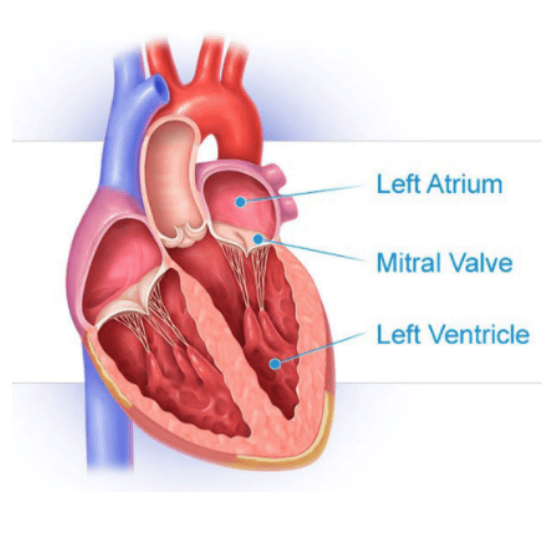About Mitral Valve Disease
In the heart, there are four major valves that ensure that blood flows in one direction. The Mitral Valve (MV) is positioned between the Left Atrium and the Left Ventricle. It’s role is to return oxygenated blood to the largest pumping chamber of the heart, prior to being pushed through the aortic valve into the aorta, and to the rest of the body.
There are two most common diseases related to the Mitral Valve, they are:
- Mitral Valve Stenosis, and
- Mitral Valve Regurgitation / Mitral Valve Insufficiency
Each valve has a number of leaflets or cusps, that allows the valve to stop blood flowing in either direction when it’s closed. Over time these leaflets may become either stiff or floppy, ultimately reducing the ability to completely close off and allowing excess blood to flow in the wrong direction, which in turn causes problems within the heart over time.
The mitral valve, in particular, has two such leaflets. Additionally, the valve is held in place by a number of papillary muscles that keep the mitral valve in place during the hearts’ contractions.1

What are the causes of Mitral Valve Disease?
Mitral Valve Stenosis is a condition where there is a narrowing of the mitral valve due to any changes that can occur as a result of either congenital defects or an acquired condition.
The most common cause of mitral valve stenosis is rheumatic fever which typically occurs as a child. Rheumatic fever causes the mitral valve leaflets to thicken and may lead to a narrowing of the mitral valve opening. This causes a restriction in the flow of blood through the mitral valve and over time calcification of the leaflets may also occur in older adults.
Congenital mitral valve stenosis may be associated with congenital heart conditions such as Coarctation of the Aorta and other congenital heart conditions, often diagnosed at birth or shortly after.2
Mitral Valve Regurgitation (MVR) may also be referred to as Mitral Valve Insufficiency.
This condition relates to the leakage of blood between the Left Atrium and the Left Ventricle which can over time cause structural changes to the size and function of the Left Atrium. These structural changes can further result in other complications such as Atrial Fibrillation.
The most common causes of mitral valve regurgitation are rheumatic fever, due to damage of the papillary muscles that hold the mitral valve in place, or in some cases damage to the heart muscle associated with a myocardial infarction (or heart attack). The degree of regurgitation or leaking determines the severity of this condition.3
To learn more about these Mitral Valve conditions, click the links below:
